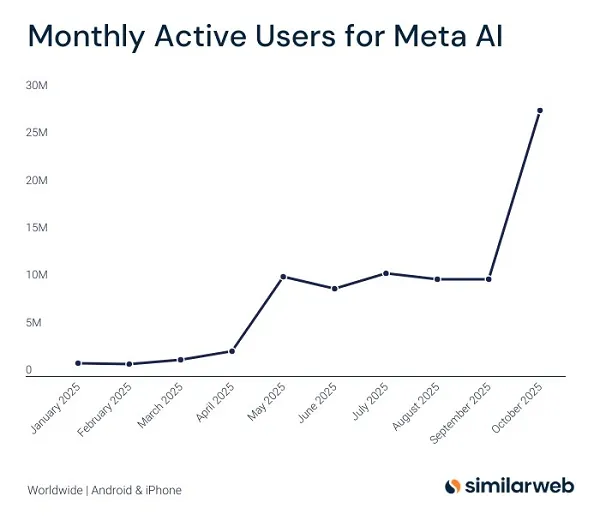So do people actually care about Meta’s various AI tools and options, like generating images of yourself in fantastical scenarios, or videos that depict whatever you choose?
Are people actually using these tools on a large scale, or is Meta more excited about them than the public?
Well, it’s hard to say, because while Meta has reported several times that its Meta AI chatbot is now the most used AI assistant in the world, Meta’s scale somewhat skews those stats, because Meta AI is built into the search function in every Meta app.
Which means that a lot of people are using Meta AI whether they intended to or not, and with 3.54 billion daily active users across its apps, that’s a lot of people who might be considered Meta AI users, but don’t specifically come to the platform for its AI tools.
A more indicative measure then would be the use of Meta’s dedicated Meta AI app, which it launched back in April, by rebranding its “Meta View” app that was initially only the companion app for its Meta Ray Ban glasses.
Though even then, there wasn’t a heap to do in the app if you didn’t have Meta AI glasses. And with Meta AI built into its other apps, even the rebrand didn’t lead to a heap more initial usage, though as you can see in this chart from Similarweb, Meta’s AI app has seen a surge in popularity of late.

You can see the shift in interest after the rebrand in April, then a big surge of late.
Some have shared this chart to underline the growing interest in Meta’s AI offerings, and how Meta is winning in the AI race. But even this spike is seemingly based on novelty, not on sustained usage and engagement.
That’s because Meta launched its “Vibes” AI-generated video content feed in the app at the end of September, reflecting the sudden spike in interest.

That led to a lot of people downloading and using the app (Similarweb says the Meta AI app was downloaded 8.8 million times in October) in order to check out Meta’s AI videos, which also means that these usage figures are skewed by curiosity, not genuine, ongoing interest or engagement.
As such, what will be more indicative will be the usage rates moving forward, and this week, Business Insider has gleaned some new insight into this aspect, after getting its hands on internal Meta data around the Meta AI app’s usage.
According to BI:
- Meta’s Vibes feed currently has around 2 million daily active users, which has declined slightly week-over-week. Which is notable when compared to the above downloads chart, which shows that the app saw some 30 million monthly actives in October. And while this is comparing daily and monthly data points, the numbers do suggest that the majority of people who download the app aren’t coming back to it very often (note: on average, social media apps see around half as many daily users as their monthly active user total).
- The majority of Vibes’ growth in early November came from India (702k daily active users) and Brazil (114k daily actives)
- Vibes is seeing 23k daily active users in Europe, after the Vibes feed was launched in EU on November 6th
- Vibes usage has declined in parts of Southeast Asia, with the Philippines seeing a 9% drop in daily actives, and Thailand seeing a 7% decline
The data suggests that Vibes is seeing a level of interest, yet usage, compared to downloads and that initial surge, seems relatively low, which suggests that a feed of AI-generated clips isn’t great at holding audience attention in any significant way.
Which is not surprising, considering the flow of junk that’s within that stream. But that could also have further implications for Meta’s broader gen AI push, as it looks to spend big on the next stage of AI development.
And Meta is super keen on getting people to try out its generative AI tools. There are now prompts in virtually every element of its apps that enable you to chat with Meta AI, or ask an AI bot a question, or tap on an AI-generated search bubble, etc.
But do people really want this? Sure, the current wave of AI tools are interesting, and LLM-based systems do have practical value in a range of contexts. But are Facebook and Instagram users really excited about generating images of themselves as astronauts, or short videos of things that don’t actually exist?
Because in my experience, the vast majority of this content would be considered “AI slop,” derivative, vacant content, which really fits that description perfectly: It’s content, as in “stuff to look at,” but it’s not particularly interesting or entertaining.
There are, of course, exceptions to this, with some AI-generated videos and images being unique and interesting, and demonstrating a novel take on the form. But that really comes down to the creativity and skill of the creator. Some AI videos might look good, but without an interesting concept behind them, it’s just a show reel of what AI can do. Some AI-generated images come out great, but that’s generally because the person doing the prompting understands the different elements of image composition, and is able to refine the output based on this.
As such, while AI tools will provide more creative opportunities, it’s human ideas that remain the core of creativity, and form the heart of social networks, where human users go to interact.
This is why AI reply prompts feel a little cold and empty, and why AI post suggestions seem, for the most part, pointless. Because social media is about being “social,” and sharing your unique perspective and opinion with others.
If you’re relying on AI tools to guide this, then what’s the point?
It feels more like a fast-track towards bots talking to more bots, and simulating human engagement, with real humans watching on as these systems regurgitate and reimagine an entire internet worth of past discussions.
Is that the kind of future we want?
And while AI prompts and tools can help to guide your thinking, why post something if you have nothing to say? Why feel a need to take up space, as if you need to fill gaps in discussion?
This is where AI bots feel intrusive and disingenuous, in being gap fillers for social apps, an additional, automated content stream that doesn’t really add anything to broader discourse.
You could argue that AI bots can help to prompt more discussion, and help people clarify their talking points, and in some cases that also may be true. But the value of your actual, personal contribution is that nobody else can replicate your perspective. Why dilute that behind some manufactured digital filter?
So while Meta’s keen to push its gen AI tools, and prompt users to explore what’s possible, and while Zuck and Co. see the current LLM-based AI push as the path to “superintelligence,” I tend to agree with now former Meta AI chief Yann LeCun, who sees LLM development as largely a dead-end in this respect, a circular loop that isn’t going to advance society in any meaningful way.
The real value of AI superintelligence, in the form of artificial general intelligence (AGI) is unlikely to come from data that already exists, but will stem from research into the development of machine systems that can replicate the human brain, and actually utilize perception and understanding, in order to truly “think” for themselves.
That’s not what LLM systems do. In fact, the suggestion that these tools are even AI is a misnomer in itself, because they’re not “intelligent” in any way, they’re just pattern-matched predictions on a massive scale.
Which, again, does have its applications, and will have major benefits in some usage. But I don’t know that it contributes much to social media as a format.












